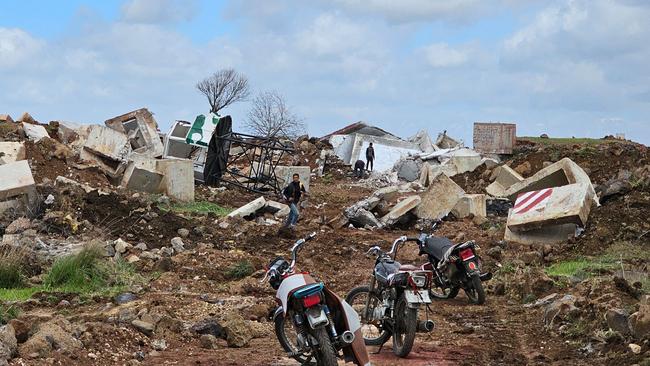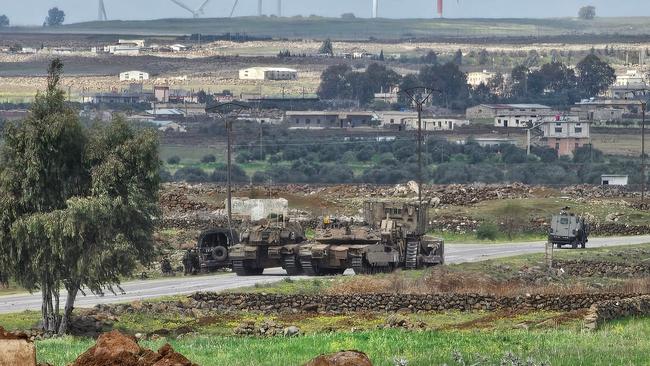In southern Syria, Israel is the power that matters
Israel’s new security strategy in southern Syria has produced a land grab and animosity along the border as troops move out of the buffer zone and closer to Damascus

There is a new boss in this frontline village. It isn’t the group of former rebels who overthrew a half-century of Assad family rule four months ago, and installed themselves as Syria’s government. Nor is it any of the armed militias south of the capital, Damascus, about 45 miles to the northeast.
It’s Israel, which, aiming to insulate itself from attacks across the border, took over the former United Nations buffer zone in Syrian territory that includes Al-Hamidiyah along with the strategic high ground nearby.
A newly built Israeli military outpost keeps watch over the village, its lights blazing even during the day, as does a Merkava tank positioned behind a berm. Teenage soldiers staff checkpoints and fan out every day on patrols, checking IDs and limiting the villagers’ movements at night.
At the village’s western edge, about a mile outside Israel’s border fence, bulldozers are carving out a tall barrier of compacted soil. Some of it crosses property that belongs to Eid al-Ali, who watched warily as his goats grazed around the earthworks, an area Israeli soldiers have made off-limits.
“I feel like I am stealing from my own land,” said Ali, 49. A few minutes later, a group of Israeli soldiers pulled up the road in a jeep. Ali turned and shouted to his wife. “Get the goats quick,” he said.
Some of the young Israeli soldiers stepped out of their vehicle. They were serving their required military service and had already been in Gaza and southern Lebanon. One said they prevent villagers from crossing the area, even to graze their livestock, for security reasons.
“They don’t like us,” the soldier said of the villagers. “It’s understandable.”
A four-day trip to southern Syria revealed the extent of Israel’s hold on the area and the challenges it is creating – not only for residents, but also for Syria’s fledgling state, which is struggling to consolidate control of a country that could fragment along ethnic and sectarian lines.

After the Assad regime fell in December, Israel wasted little time dismantling an old enemy and hamstringing what could be a new one in the former al Qaeda affiliate that has installed itself in Damascus. Israel’s air force and navy launched hundreds of strikes that wiped out what remained of the Assads’ military, while ground forces seized Syrian-controlled areas of the Golan Heights within a United Nations-monitored demilitarised zone that had existed for a half-century.
Israeli Prime Minister Benjamin Netanyahu has demanded that Syria demilitarise the south and has warned forces of the new regime to stay out. Israel’s defence minister has said its troops will remain in Syria indefinitely.
Anchoring Israel’s presence is a string of military outposts near villages, on hilltops and in forested areas inside the U.N. zone, giving Israel oversight of a 150-square-mile (240-sq-km) area and a 50-mile border abutting Israeli communities in the Golan Heights and northern Israel.
Since Feb. 10, Israel has launched 89 ground incursions and 29 air and artillery strikes across southwestern Syria, as well as 35 other air strikes elsewhere in the country, according to data compiled by Charles Lister, a Syria analyst who runs the Syria Weekly newsletter.
On Friday, thousands of Syrians across several cities joined demonstrations to protest Israel’s military activity in Daraa, a southwestern province where Israeli forces have raided homes and clashed with armed groups.

Roadblocks and restrictions
Israeli tanks and vehicles rolled into Al-Hamidiyah the day after the Assad regime fell.
Arabic-speaking soldiers ordered residents to leave their houses for a couple of days and hand over weapons as they searched homes and buildings. When villagers returned, some said they found their houses destroyed or ransacked. Some buildings had Hebrew writing on the walls.
The main road into Al-Hamidiyah is blocked, forcing villagers to take a long detour to reach their homes. Israeli soldiers positioned at a narrow bridge leading into the hamlet stop people and photograph their IDs.
No one is allowed to leave or enter the village at night, though they can move around inside, residents said. During Ramadan, families couldn’t visit relatives in other villages for the traditional sundown meal to break their fast. On two recent occasions, village elders had to seek permission from Israeli military liaisons to allow residents needing emergency medical care to travel to the nearest hospital at night, said Turki al-Mostafa, a village elder. Both survived.
Israeli troops have limited the size of funerals and restricted the traditional three days of mourning, where typically hundreds of wellwishers come to pay their respects, villagers said.
In a region with high levels of unemployment and poverty, Israeli troops have provided food packages to villagers to improve the military’s image. Some residents have accepted, but many others have refused.
“They have destroyed our houses,” said a thin, sparrow-like woman standing in the middle of fresh tank tracks in front of her neighbour’s collapsed house in the village of Rasm Al-Rawadi. “Why would I accept food from them?”

An Israeli military official said soldiers conduct day and night operations to ensure security. Activities such as burials inside the buffer zone or anywhere else Israeli forces operate require co-ordination, the official said. There is no curfew in Al-Hamidiya, but movement is controlled. Most of the destruction in the province dates back to Syria’s civil war, the official said.
“We don’t want to hurt the civilian population,” the official said. The Israeli presence picks at old wounds. Many older villagers were among tens of thousands of Syrians who were forced from their homes in the Golan Heights when Israel occupied the region in 1967. After a 1974 ceasefire agreement that ended another war, a third of the Golan reverted to Syrian control. That area is now occupied by Israel.
In January, Israeli soldiers opened fire and injured protesters at an anti-Israel march in Sweissa village, southeast of Al-Hamidiyah. Israeli troops have also detained some young Syrians, including shepherds, in both Quneitra and Daraa provinces, and some are still in Israeli custody, said Dirar al-Basheer, the former governor of Quneitra.
“If Israel continues its occupation, and keeps bullying and harassing people, this area will become a conflict zone,” Basheer said. “All the extremists of the world will come over here to wage jihad.” Israel has only detained people suspected of terrorist activity, the Israeli military official said.

Strategic shift
Israel’s move into Syria reflects a strategic shift after the Oct. 7, 2023, attacks that left about 1,200 dead, 251 taken hostage and sparked a year and a half of war. No longer willing to play defence along its borders, Israel has carved out buffer zones – around Gaza, in Lebanon and now in Syria – as insulation against further attacks.
The Assad regime was among Israel’s most powerful enemies for decades. The Islamist rebels who replaced it are deeply mistrusted by Israel and much of the Arab world. Syrian Interim President Ahmed al-Sharaa says he is no longer an extremist and has been careful not to confront Israel, but his government remains untested and dominated by Islamists.
Many people in southern Syria – and across the country – are wary of the new government as well. At the northern tip of Quneitra Province, an Israeli military outpost overlooks the majority Druze village of Al-Hader. Many here were Assad loyalists, and nearly everyone has ties to Israeli Druze.
Israel is courting Druze with offers of jobs and has vowed to protect them. Some have embraced Israel, but many others said they fear being labelled collaborators and targeted by Sunni Muslim or even Druze militias.
“My main worry is these statements will bring sectarian conflict between the Druze and the Sunnis,” said Faraj Saker, a Druze community leader, referring to Israel’s public declarations of support. “They have even created divisions within the Druze community.”
“We feel cornered between Israel who doesn’t represent us and a government who doesn’t represent us,” he said, adding that Israel remains an enemy.
“If we had jobs here, no one would even think of going to Israel,” said Jowdat al-Taweel, another prominent Druze leader here.
Israeli forces are now expanding deeper into southwestern Syria, outside the UN buffer zone. They are moving south of their military bases into new areas in Daraa province, roughly 60 miles from Damascus.
Israeli tanks and bulldozers have entered villages, taking down buildings and erecting barriers on roads, while searching homes for weapons and suspected militants.
Last week, Israeli forces clashed with armed groups in the town of Tasil, leaving nine dead, provincial authorities said. Israeli troops were carrying out a night raid when militants attacked, sparking gunbattles and air strikes, Israel’s military said, adding that several militants were killed.
At a recent Friday prayer in Izraa, the imam called for worshippers to “stand united with the new government, which has restored Islam to the state.” Then he called for jihad “against those destroying the security of Syria, destroying what the revolution accomplished.” He named three targets: the remnants of the Assad regime, the Shiite Lebanese militant group Hezbollah and Israel.
The Wall St Journal



To join the conversation, please log in. Don't have an account? Register
Join the conversation, you are commenting as Logout